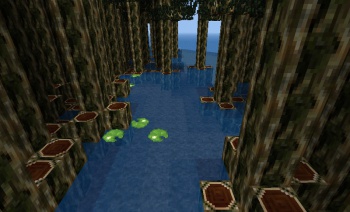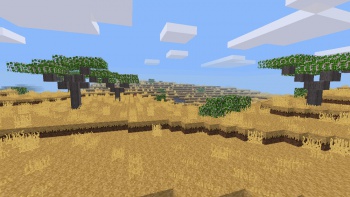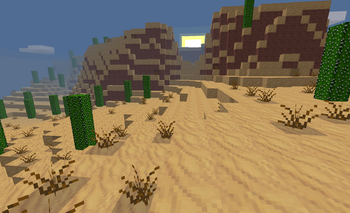Biomes/ms
| English • Deutsch • français • Bahasa Indonesia • 日本語 • Bahasa Melayu |
Biom (BI: biomes) dalam Minetest adalah sebahagian daripada penjanaan peta. Biom ialah kawasan dengan daratan, bawah tanah dan tumbuh-tumbuhan yang serupa.
Jenis-jenis biom
Biom bergantung kepada penjana peta yang digunakan. Kebanyakan penjana peta mempunyai biom yang sama kecuali dalam janapeta v6.
v5, v7, valleys, flat, fractal
Biom dalam penjana peta ini ditakrifkan oleh mods. Jika ia tidak ditakrifkan, kesemua penjana peta ini hanya menjana dunia batu. Biom dalam penjana peta ini tidak berkait dengan bentuk rupa bumi; ini bermakna mana-mana biom (termasuk kawasan rumput) boleh terbentuk dekat kawasan rata atau kawasan bergunung. Bahagian ini menunjukkan biom yang digunakan dalam Minetest Game.
| Nama dan Ciri-ciri | Keterangan | Gambar |
|---|---|---|
| Kawasan rumput (BI: Grassland) Batu, Tanah, Tanah Berumput, Rumput, Bunga, Daun Belukar, Batang Belukar |
Kawasan rumput mempunyai jumlah nod tanah dan blok tanah berumput yang sangat banyak, yang mana bunga-bungaan, rumput dan belukar boleh wujud secara semulajadi di kawasan ini. Bawah tanahnya diperbuat daripada batu. | |
| Hutan konifer (BI: Coniferous forest) Batu, Tanah, Tanah Berumput, Kayu Pokok Pain, Daun Pain, Rumput, Bunga, Cendawan Merah, Cendawan Perang |
Hutan konifer membesar di kawasan yang lebih sejuk dan diisi dengan pokok pain. Hutan pokok pain juga boleh dilitupi salji di kawasan sejuk. | |
| Hutan daun luruh (BI: Deciduous forest) Batu, Tanah, Tanah Berumput, Kayu Pokok Biasa, Daun Biasa, Kayu Pokok Aspen, Daun Aspen, Epal, Cendawan Merah, Cendawan Perang, Daun Belukar, Batang Belukar |
Hutan daun luruh ialah salah satu biom paling lazim dijumpai dalam Minetest dan terbentuk di kawasan lebih panas. Pokok biasa, pokok epal dan pokok aspen tumbuh secara semulajadi di kawasan ini. Selalunya hutan ini boleh ada tasik, kolam dan sungai di dalam kawasannya. Hutan daun luruh biasanya mengelilingi kawasan lapang. | |
| Hutan hujan (BI: Rainforest) Batu, Tanah, Tanah Bersarap Hutan Hujan, Rumput Hutan, Kayu Pokok Hutan, Daun Hutan, Cendawan Perang, Teratai |
Hutan hujan (atau rimba) diperbuat daripada pokok hutan besar yang tumbuh secara rapat bersama. Rumput hutan dan kayu pokok hutan yang memegang daun hutan wujud secara semulajadi di sini. Dekat kayu balak pokok hutan tumbang, jarang-jarang ada cendawan perang. Hutan dekat dengan laut mencipta paya penuh dengan teratai. | |
| Savana (BI: Savannah) Batu, Tanah, Tanah Berumput Kering, Rumput Kering, Kayu Pokok Akasia, Daun Akasia, Daun Belukar Akasia, Batang Belukar Akasia, Teratai, Papirus |
Savana ialah daratan kering yang bukan gurun, ia kawasan yang mempunyai pokok akasia dan rumput kering. Air rata bersempadan dengan savana berkemungkinan untuk mempunyai teratai dan papirus. | |
| Gurun (BI: Desert) Batu Gurun, Pasir Gurun, Kaktus, Pokok Renek Kering |
Gurun mengandungi pasir gurun dan batu gurun yang sangat banyak. Kaktus dan pokok renek kering juga wujud secara semulajadi atas daratan gurun. Kaktus boleh terbentuk dalam dua bentuk berbeza. Gurun terbentuk di kawasan panas dan kering. | |
| Gurun batu pasir (BI: Sandstone desert) Pasir, Batu Pasir, Pokok Renek Kering |
Gurun batu pasir ialah kawasan tandus luas yang dilitupi pasir dengan batu pasir di bawahnya. Mereka terbentuk dalam klimat suhu tinggi dan kering. | |
| Gurun sejuk (BI: Cold desert) Pasir Perak, Batu, Pokok Renek Kering |
Gurun sejuk ialah kawasan tandus luas yang dilitupi dengan pasir perak di atas batu. Mereka terbentuk di kawasan sejuk dan kering. | |
| Kawasan rumput bersalji (BI: Snowy grassland) Batu, Tanah, Salji, Tanah Bersalji, Daun Belukar, Batang Belukar |
Biom kawasan rumput bersalji selalunya berada di sempadan kawasan berumput dan dilitupi dengan lapisan salji nipis di atas tanah bersalji. Beberapa belukar dilitupi salji boleh dijumpai di sini. | |
| Taiga (BI: Taiga) Batu, Tanah, Salji, Tanah Bersalji, Kayu Pokok Pain, Daun Pain, Pokok Renek Kering, Cendawan Perang, Cendawan Merah |
Taiga ialah biom sejuk dilitupi salji dengan tumbuh-tumbuhan yang kaya beserta permukaannya yang penuh dengan salji dan tanah bersalji. Mereka kaya dengan pokok pain yang dilitupi salji. Dalam hutan pokok pain, jarang-jarang ada cendawan tumbuh di atas kayu balak pokok pain tumbang. | |
| Tundra (BI: Tundra) Batu, Bongkah Salji |
Tundra ialah biom tandus di klimat sangat sejuk tanpa sebarang tumbuh-tumbuhan dan hanya ada selapis bongkah salji di atas batu. Mereka biasa dijumpai di antara taiga, kawasan rumput bersalji dan glasier. Ini salah satu biom di mana bongkah salji (dan bukannya salji biasa) dijana. | |
| Glasier (BI: Glacier) Ais, Bongkah Salji |
Glasier hanya terbentuk dalam kawasan paling sejuk dan diperbuat daripada ais yang sangat banyak, dilitupi lapisan bongkah salji yang tebal tanpa sebarang tumbuh-tumbuhan. Biom glasier boleh terbentuk bergunung seperti dalam tangkapan layar atau sangat rata. Biom glasier selalunya bersempadan dengan biom kepingan ais berhampiran lautan. | |
| Kepingan ais (BI: Ice sheet) Ais, Bongkah Salji |
Kepingan ais hanya terbentuk dalam kawasan paling sejuk di atas lautan dan selalunya bersempadan dengan biom glasier. Kepingan ais sangat rata dan mempunyai selapis bongkah salji dengan ais di bawahnya sehingga 10 lapis, “terapung” di atas air di laut dalam. |
v6
Template:Incomplete translation/ms The v6 map generator has a predefined set of biomes which can't be changed by mods directly. The outcome in different subgames will generally be very similar. In general, v6 biomes are a lot simpler than the biomes of the other map generators.
Biomes
| Name | Main Blocks[1] | Decorations[2] | Description | Images |
|---|---|---|---|---|
| Plains | Stone, Dirt, Dirt with Grass | Grass, Flower | Plains are a quite flat biome. Large amounts of Dirt nodes and Dirt with Grass blocks, on which flowers and Grass may appear naturally (since 0.4.7). There are no bushes. The underground is made of stone. | |
| Forest | Stone, Dirt, Dirt with Grass, Tree, Leaves, Apple | Grass, Flower | Forests are one of the most common biomes in v6 and form in temperate zones. Regular trees and apple trees grow here naturally. Forests usually surround plains. There are no aspen trees or fallen tree logs. | |
| Desert | Desert Stone, Desert Sand | Cactus, Dry Shrub | Deserts contain large amounts of desert sand and desert stone and often form large cliffs or canyons. Cacti and dry shrubs also spawn here naturally in clusters on desert sand. Deserts spawn underground rivers and lakes which can be over 200 blocks deep. In v6, cacti only form in a “column” shape of up to 4 blocks high. | |
| Jungle | Stone, Dirt, Dirt with Grass, Jungle Tree, Jungle Leaves, Jungle Grass | Flower, Grass | Jungles contains large trees which grow thickly packed together. Jungle Grass and Jungle Trees bearing Jungle Leaves spawn here naturally. Jungles in v6 very similar to the jungles in the other map generators, but there are no fallen tree logs, mushrooms or swamps.
Although technically possible, flowers and grasses only appear rarely in this biome. |
|
| Taiga | Stone, Snow Block, Dirt with Snow, Snow, Pine Tree, Pine Needles | The surface is covered with snow blocks on top of dirt with snow. Snow-covered pine tree forests are common in this biome. | ||
| Tundra | Stone, Dirt with Snow, Snow | Dry Shrub | Tundras are large open fields with thin layers of snow and are populated by dry shrubs. There are two variations of this biome. | |
| Ice sheet | Ice, Water | Ice sheets are two layers of ice on top of ocean water. They generate bordering directly to taigas and tundras. |
- ↑ Blocks generated by the core v6 mapgen
- ↑ Additional blocks added by Minetest Game, can be controlled with the map generator flag
decorations. See also: Map generator features#Shared features
Landscape features
Landscape features form (more or less) separately from biomes.
| Name | Blocks | Description | Images |
|---|---|---|---|
| Sand beach | Water, Stone, Sand, Clay | Sand beaches are made out of sand and form at at height of Y=2 and below, which is near the sea level by default. Sand beaches often extend deep into the ocean, which can easily turn a large part of the ocean floor into sand. The sand replaces the floor of other biomes. Depending on the terrain shape, sand beaches can be short or very long and wide (as seen in the screenshot). Clay can be found in the sand and forms in small to medium-sized “blobs” underwater (Technically, clay is generated as an ore by Minetest Game).
Sand beaches are generated based on height and Perlin noise; they technically form independent of the water of oceans. This effect can be noted if the water level (with the setting |
|
| Ocean | Water, Stone, Dirt, Sand | Oceans are a landscape feature that seemed to be implemented around 0.2.20110731_1 Pre-Alpha. An ocean is just a large body of water that can be up to 250 blocks deep. They may be referred to as lakes, but are called oceans because they can be so huge, sometimes even 200-350 blocks across. The natural ocean floor is dirt, but sand is also common because of sand beaches. | |
| Island | All blocks from the v6 biomes, Water | Islands occur many times in oceans. Islands usually raise out of the ground 3-10 blocks, but can get as large as 40-80 blocks tall. | |
| Mountain | Blocks are similar to those of forests and plains | Mountains are the most treacherous to scale. Trees grow here naturally. It is quite easy to be killed in a mountain landscape if you don't pay attention to where you are going. | |
| Plateau | Almost all blocks from the v6 biomes | A giant structure that seems to have appeared from version 0.4 on, plateaus are very common in deserts but also in mountainous terrain. Plateaus can even float above ground and generate miniature biomes on top of it. | |
| Water cave | Stone, Water | Water caves are caves that only occur at sea level, which turn into a huge underground river or lake. In extreme cases, these caves can lead thousands of blocks down and are extremely easily to get lost in. | |
| Gravel area | Gravel | Very rarely, unusually large areas of gravel can appear on the surface. These areas consist of nothing but gravel. |
History
Before Minetest had version numbers, biomes were undefinable and only consisted of 4 materials: grass, stone, light and "water" (as seen below.) When 0.0.1 came out it brought actual biomes to the table, but before 0.2.20110529 Pre-Alpha map generation was a bit of a mess. Biomes would cross into each other, and were generally undefinable. So far 0.4 Dev has the most stable biome generation.
For more detail on the evolution of the map generator see the Map Generator Evolution page.
| English • Deutsch • français • Bahasa Indonesia • 日本語 • Bahasa Melayu |






























